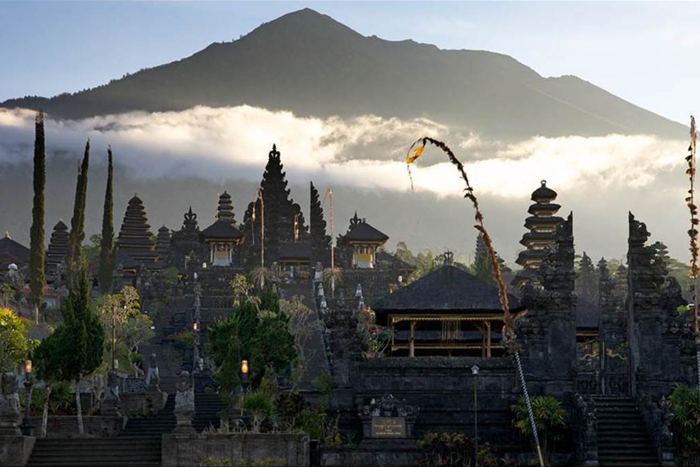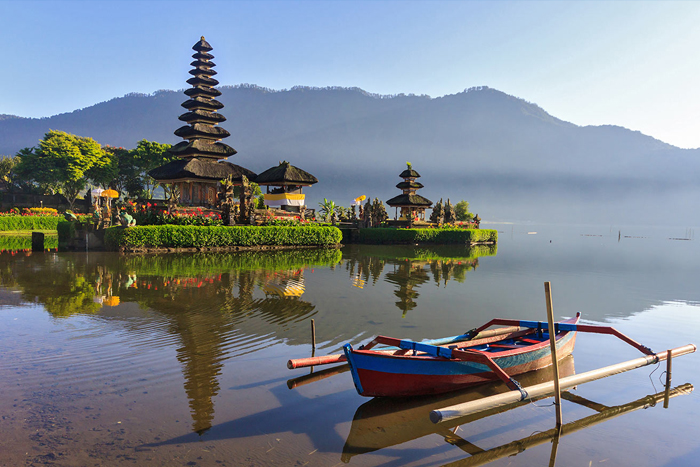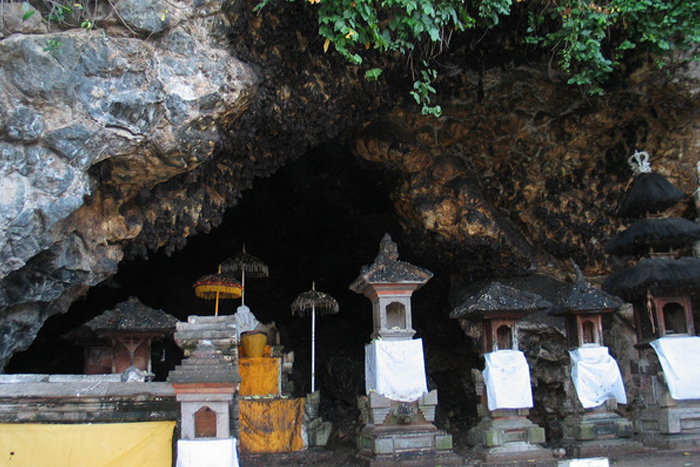5 top Bali Temple
Tanah Lot

Tanah Lot is one of Bali’s directional temples, and is situated on a rock in the ocean, just offshore. From all the beautiful temples on Bali, Tanah Lot is quite special and for many one of the “must-things-to-do”.
It is said that Pura Tanah Lot has been built on the recommendation of an important Hindu priest Danghyang Nirartha in the 16th century, who has shaped Bali’s Hinduism and religious architecture for the centuries to come.
Tanah Lot is a very important site for pilgrimages and plays an important role in Balinese spiritualism and mythology. The rock that the temple sits on has been eroded by the ocean over the centuries, and is now undergoing a process of restoration.
Besakih

Besakih is known as the Mother Temple of Bali and is simply the most important temple for the whole of the island. It’s actually more like a complex of temples in one very large compound and its known and loved for is its dramatic location on the southern slopes of Sacred Mount Agung. It is known as and accepted as Bali’s Mother Temple for more than a thousand years. Besakih is quite unique as it basically consists of more than 80 individual temples. The main one is Pura Penataran Agung (the Great Temple of State).
A stone within Pura Batu Madeg suggests that the area around Pura Besakih was already regarded a sacred and holy since very ancient times. In Bali, many temples and their meaning cannot be separated from the land they are built on, the nature and the spirits and gods they believe do actually live there.
The priests let us know that during the 8th century, a Hindu monk had revelations to build homes on this holy ground. They say during the process, apparently many of his followers died due to illness and even accidents. Stories like this are the brickstones of legends so it is difficult to get the historic truth. The people called the area “Basuki”. A name referring to “Naga Besukian”, a dragon deity inhabiting Mount Agung.
Additional temple shrines were constructed and Besakih was established as the main temple complex around 1340.
Besakih was hit a few times by earthquakes (e.g. 1917) and also several volcanic eruptions of Mount Agung took their toll, particularly a major one in 1963. The complex did get damaged here and there but in 1963 the the lava flow did pass sparing the temple from complete destruction. This event is now of course part of the overall legend of Pura Besakih. The people believe that the deities showed their true power but without destroying the holy temple completely.
Besakih being the biggest and holiest of the island’s temples plays a significant role not only for the villages and families nearby but for entire Bali. Many important festivals are celebrated here. It is a temple open to every devotee – from any caste groups. It is simply the prime spiritual centre for all Balinese.
Pura Ulun Danu Bratan

Pura Ulun Danu Bratan, or Pura Bratan, is a major Shivaite and important water temple (not to confuse with the other major water temple being Pura Ulun Danu Batur). The temple site is located in the mountain highlands near Bedugul on the shores of Lake Bratan. It was built around 1663 and is used to worship the lake and river goddess Dewi Danu.
This picturesque site is featured on an Indonesian banknote and is definitely one oft the important and also well-known landmarks of Bali.
Uluwatu

This cliff-top temple is indeed impressive. The temple is built on the steep cliff and coming here can feel like sitting one the throne of Bali. During sunset hours the atmosphere gets really mystical.
Uluwatu Temple (Pura Uluwatu or also known as Pura Luhur) is one of Bali’s nine key directional temples (Pura Kayangan Jagat). Though a small temple was claimed to have existed beforehand, based on inscriptions the structure was either instigated or significantly expanded by a Javanese sage, Empu Kuturan in the 11th Century. He was a Majapahit monk, who took also part in establishing several other temples on Bali.
Another sage from East Java, Danghyang Nirartha (Dwijendra) is credited for constructing the padmasana shrines and is claimed to have attained Moksha at Uluwatu. Legends suggest that he reached the highest spiritual point of oneness with the gods by a strike of lightning and completely disappeared.
You can enter the temple area through two entrances that are split gates. They are surrounded by a couple of Ganesha sculptures (shaped like a human body with an elephant head). Behind the main shrine lies a Brahmin statue facing the Indian Ocean. Until the early 80ies it was rather difficult to get here.
Goa Lawah/Bat Cave Temple

The Bat Cave temple is located at the south east coast of Bali, roughly 10km away from Klungkung, 10km south of Candidasa in the village of Pasinggahan. It’s just beside the main road tot he eastern part of Bali such as Candidasa, Padangbai, Karangasem, Amlapura and next to a beautiful black sandy beach. From here you can see at the horizon the coast of Nusa Penida.
It’s now a common stop for heading towards the east. For tourists and worshipping locals who are on their way and stop to give offerings and pray.
The rather large temple complex is built around the entrance to a cave that is home to many, many, many! bats. Goa Lawah translates into Bat Cave for a good reason. You will see two large, majestic banyan trees at the main entrance.
Some shrines in the centre are ancient from the time the temple has been established. Take notice of the motifs of the dragon who is in charge of keeping the universe at balance.
Source: https://www.bali.com/temples-religious-sites.html

